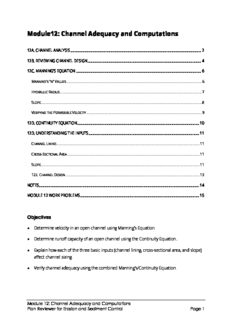Table Of ContentModule12: Channel Adequacy and Computations
12A.CHANNELANALYSIS.........................................................................................................................................2
12B.REVIEWINGCHANNELDESIGN.......................................................................................................................4
12C.MANNING’SEQUATION...................................................................................................................................6
MANNING'S"N"VALUES.....................................................................................................................................................6
HYDRAULICRADIUS............................................................................................................................................................7
SLOPE.................................................................................................................................................................................8
VERIFYINGTHEPERMISSIBLEVELOCITY...............................................................................................................................9
12D.CONTINUITYEQUATION................................................................................................................................10
12D.UNDERSTANDINGTHEINPUTS....................................................................................................................11
CHANNELLINING..............................................................................................................................................................11
CROSS-SECTIONALAREA..................................................................................................................................................11
SLOPE...............................................................................................................................................................................11
12E.CHANNELDESIGN....................................................................................................................................................13
NOTES........................................................................................................................................................................14
MODULE12WORKPROBLEMS.............................................................................................................................15
Objectives
DeterminevelocityinanopenchannelusingManning’sEquation.
DeterminerunoffcapacityofanopenchannelusingtheContinuityEquation..
Explainhoweachofthethreebasicinputs(channellining,cross-sectionalarea,andslope)
affectchannelsizing.
VerifychanneladequacyusingthecombinedManning’s/ContinuityEquation.
Module 12:Channel AdequacyandComputations
PlanReviewer for ErosionandSedimentControl Page 1
12a. Channel Analysis
Channeladequacyformanmadechannels:
ManmadeChannelMustconveythe10-yearstormwithoutovertoppingandthe2-year
stormwithouteroding.
Pipes—Mustconveythe10-yearstorm.
Itisimportantforthereviewertobefamiliarwiththecapacity(runoff/Q)anderodibility
(velocity/V)requirementsinordertoverifytheadequacyofstormwaterconveyancechannelsand
pipesystemsassociatedwithadevelopmentproject.Formoreinformationonhowconveyance
channelsareanalyzedtodetermineiftheymeettheserequirements,consulttheVESCH,Chapter5,
PartIII.Estimatingpeakrunoffratesandrunoffvolumesarecriticalinthedesignandsizingof
manmadechannelsanddrainageditches.RecallfromModule12thatamanmadechannelmust
conveythe10-yearstormwithoutovertoppingandthe2-yearstormwithouterodingtomeetthe
channeladequacydefinition.
Thenextfewsectionsofthismodulediscussthetwoprincipalequationsthatgointosizing
manmadechannelsandditchesandverifyingbothcapacityandvelocity:Manning’sEquationfor
determiningvelocityinanopenchannelandtheContinuityEquationfordeterminingrunoff
capacityofanopenchannel.Understandingthesecalculationsandtheirinputsiscriticalto
ensuringthattheboththesizeofachannelanditsliningareadequatetohandleflowfroma
developmentproject.
Module 12:Channel AdequacyandComputations
PlanReviewer for ErosionandSedimentControl Page 2
Ingeneral,verificationofchanneladequacyshouldincludethefollowing::
Channelgeometry
Aminimumofthreechannelcross-sectionsshouldbetakenataminimumspacingof50’alongthe
channellengthdownstreamofthedischargepoint.Thechanneltopofbankshouldbewelldefined
andidentifiablebyfieldparameterssuchasaflatteningorchangeinbankslope,flattened
vegetationinthedirectionofflow,soiltypesorotherobviousindicatorsoffrequentflowlevels.
Whenthetopofbankdoesnotappeartobeobvious,ahydrologicanalysisofthecontributory
drainageareaandthecorrespondingtwo(2)-yearundevelopedpeakdischargemaybeusedto
definethecross-sectionalflowareausingManning’sequation.
Channellining
Thechannelliningmaterialshouldbeevaluatedtodeterminethepermissiblevelocitiesasfoundin
Table5-22oftheVESCH.
Slope
Theseinclude,fornaturalandmanmadeconveyance,respectively:
Channelslope:Relativeelevationsshouldbetakenalongthechannellengthatthechannel
cross-sectionsinordertodeterminetheaveragelongitudinalslopeofthechannel.
Energyslope:Ahydraulicgradelinecalculationshouldaccompanyanyanalysisofan
existingorproposedpipesystemtoverifythattheflowiscontainedwithinthesystem
duringtheten(10)-yearfrequencystorm.
Channelsurvey:
Adesignermustinvestigateeachchannelsegment(reach)toaccuratelydeterminetherelevant
channelcharacteristics(e.g.,slope,cross-section,roughness,downstreamrestrictions,etc.).This
informationisthenusedtotoverifychanneladequacy
PartIIIofChapter5oftheVESCHshouldbeconsultedforadditionalinformationondetermining
channeladequacyandchannelanalysis.
Module 12:Channel AdequacyandComputations
PlanReviewer for ErosionandSedimentControl Page 3
12b. Reviewing Channel Design
RefertotheStormwaterConveyanceChannelErosionStandardsandSpecification3.17orthe
applicableVirginiaStormwaterBMPSpecificationtoverifycorrectdesignspecifications.For
example,ESCSpecification3.17requiresthefollowing:
• Topwidthofparabolicandv-shapedchannelsnottoexceed30’
• Bottomwidthoftrapezoidandgrasslinednottoexceed15’
• Outletprotection
• Grasslinedchannelsstabilizedbythepermanentseedingand/orsodspecification
• Erosionnetting
• Riprap(useStd&Specs)
Module 12:Channel AdequacyandComputations
PlanReviewer for ErosionandSedimentControl Page 4
Module 12:Channel AdequacyandComputations
PlanReviewer for ErosionandSedimentControl Page 5
12c. Manning’s Equation
Manning'sEquationisusedtocalculatethevelocityofflowinanopenchannel:
1.49
V R(2/3) s
n
Where:
V=the average velocity in the channel (feet/second)
n=Manning’sroughnesscoefficientbasedonchannellining(dimensionless)
R=hydraulicradius=Area/Perimeter(feet)
A=wettedcrosssectionalareaofflow(squarefeet)
P=wettedperimeterofthecross-sectionalareaofflowperpendiculartoflow
direction(feet)
s=slopeofthechannel(infeet/foot)
Manning's "n" Values
ThefirstinputintotheManning'sEquationistheManning's"n"value,alsoknownastheManning's
roughnesscoefficient.The"n"valueisadimensionlessnumberthatisusedtoassignavaluetothe
roughnessofachannel.Ingeneral,smoothersurfaceshavelower"n"valuesandroughersurfaces
havehigher"n"values.Table5-12intheVESCH(pageV-118)providesrangesof"n"valuesfor
channellinings(concreteandasphalt)andpipelinings(corrugatedmetalandconcrete).Table5-16
(pageV-135)provides"n"valuesfornaturalchannels.TheVESCHpresentsaseriesofmodifiersto
beusedwiththevaluesobtainedfromTable5-16.Thesemodifierstakeintoaccountcharacteristics
suchaschannelirregularity,variationinchannelcrosssections,effectofobstructions,vegetation
andflowconditions,andsinuosity.TheVESCHalsooutlinestheprocedureformodifyingthe"n"
value(pagesV-123andV-124).
Module 12:Channel AdequacyandComputations
PlanReviewer for ErosionandSedimentControl Page 6
Table12.1presentsaseriesof"n"valuesforartificialandnaturally-linedchannels.Anaverage"n"
valueusedforsizinggrassditchlinesis0.05(seeTable12.1,sectionIV,subsetB).TheVDOT
Drainage Manualusesan"n"valueof0.05forgrass-linedchannelsonitsseriesofchannelcharts.
Hydraulic Radius
Inordertocalculatethehydraulicradiusofthechannel(A/P),thecross-sectionalarea(A)ofthe
channelandthewettedperimeter(P)needtobedetermined.
Area
Thearea(A)representsthecross-sectionalareaofthechannel.Therearethreemaintypesof
channelcross-sections—vee,trapezoidal,andparabolic.Eachofthesecrosssectionshasitsown
equationfordeterminingarea.TheseequationsarepresentedinPlate5-28oftheVESCH(pageV-
111).
WettedPerimeter
Thewettedperimeter(P)isthelengthofthechannelcross-sectionthatisincontactwiththeflow
ofwater.Figure12.1illustratesthisconcept.
Figure12.1WettedPerimeter
Theequationsfordeterminingthewettedperimeterforseveralchannelcrosssectionscanbe
foundinTable12.2.Usingtheareaandthewettedperimeter,thehydraulicradius(A/P)ofthe
channelcanbecalculated.Plate5-28oftheVESCH(pageV-111)incorporatesthisintoonestep,
providinganequationforthehydraulicradiusofthethreeprimarychannels(v-shape,trapezoidal,
andparabolic).
Module 12:Channel AdequacyandComputations
PlanReviewer for ErosionandSedimentControl Page 7
Slope
ThefinalinputintotheManning'sequationischannelslope.Thisiscalculatedjustlikeanyother
slope(rise/run).Theslopeofthechannelrelatestotheelevationchangeinfeet,dividedbythe
lengthofthechannelinfeet,astakenfromtheplan.
Table12.2EquationsforChannelCross-Sections
Module 12:Channel AdequacyandComputations
PlanReviewer for ErosionandSedimentControl Page 8
Verifying the Permissible Velocity
Oncethereviewerverifiestheaveragevelocityinthechannel(V),theproposedchannelliningcanbe
evaluatedforadequacyatthatvelocity.Table5-22(pageV-140)intheVESCHprovidesalistof
permissiblevelocitiesbasedonsoiltypesforunlinedearthenchannels. Incaseswherethechanneltends
tomeander,areductioninpermissiblevelocityiscalculatedusingTable5-23(pageV-141).Table3.17-A
(pageDI-135)intheStormwaterConveyanceChannelsection(Chapter3)oftheVESCHprovides
permissiblevelocitiesforgrass-linedchannels.Ifthevelocityinthechannelislessthanthepermissible
velocity,thenthechanneldesignisconsideredtohaveadequateerosionresistance.Ifthevelocityinthe
channelishigherthanthepermissiblevelocity,thenthechannelliningneedstoberedesignedtoprovide
additionalerosionresistance.
Module 12:Channel AdequacyandComputations
PlanReviewer for ErosionandSedimentControl Page 9
12d. Continuity Equation
Oncethecross-sectionalareaandthevelocityofthechannelareknown,thecapacity("Q")canbe
determinedusingtheContinuityEquation.
TheContinuityEquationis:
ܳWh=ereܸ, × ܣ
Q=flowrateinthechannelincubicfeetpersecond(cfs)
V=theaveragevelocityinthechannel(feet/second)fromManning'sEquation
A=crosssectionalareaofthechannelinsquarefeet
Thechannelcapacity(Q)shouldbeabletoaccommodatethepeakrateofrunoff(Q)fromthesite
(refertoUnitVIIIandUnitIXforhowtodeterminethepeakrateofrunoff).Ifthecapacityofthe
channelisgreaterthanthepeakrateofrunofffromthesite,thenthevelocityshouldbecalculated
usingtheactualdepthofflow.
Module 12:Channel AdequacyandComputations
PlanReviewer for ErosionandSedimentControl Page 10
Description:n = Manning's roughness coefficient based on channel lining (dimensionless). R = hydraulic radius = Area/Perimeter (feet). A = wetted cross sectional

